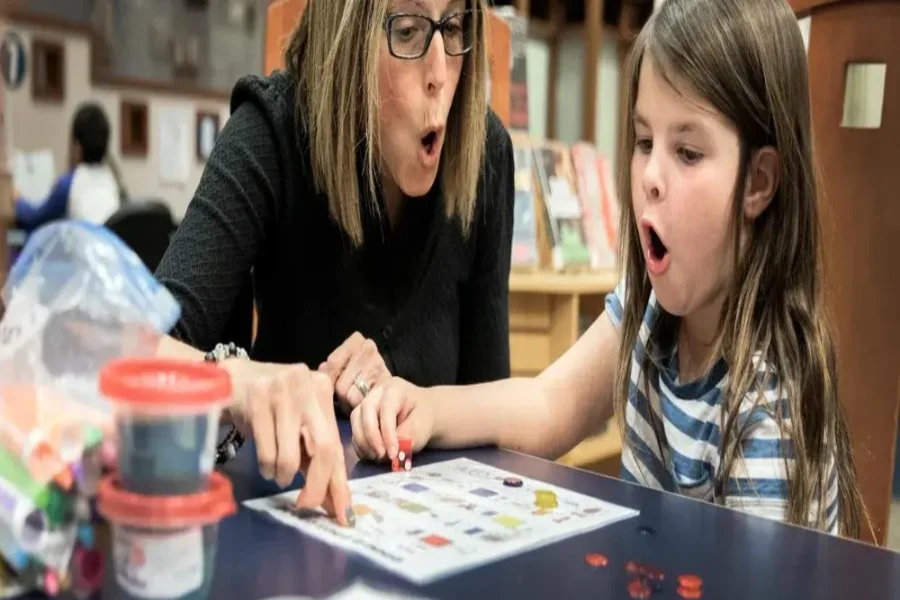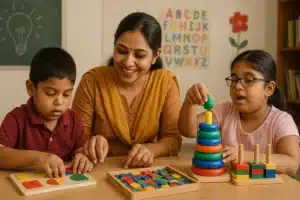
Source: gearedtolearn
Dyspraxia a learning disability, suggestively affects an individuals motor skills, including tasks such as handwriting, maintaining balance, and playing sports like basketball or football. Despite these encounters, it’s vital to comprehend that dyspraxia does not impact a person’s intelligence.
Kids with dyspraxia may find it problematic to synchronize complex muscle movements required for events like dancing or cutting with scissors, which are upfront for others children’s but become considerable hurdles for them.
This blog explores into why dyspraxia is considered a learning disability, discovering both the struggles and the help available to those affected. Through comprehending dyspraxia as a learning disability, we can better help those who navigate these daily challenges, safeguarding they have the tools and policies to succeed.
Do Learning Disability Training Courses include Specific Learning Disabilities?
Courses on learning disabilities are intended to offer teachers, parents, and other caregivers the abilities and information required to assist people with a range of difficulties. An in-depth focus on Specific Learning Disabilities is one of the main features of these courses, which guarantees that participants can identify and meet the requirements of people they assist.
Aim of the Course: The primary goal of these training sessions is to provide comprehensive strategies and insights into managing and teaching individuals with Specific Learning Disabilities effectively. This includes understanding the unique aspects of each condition and applying tailored interventions.
Coverage of Major Learning Disabilities:
- Dyslexia: Issues with reading, writing, and understanding letters and words.
- Dyscalculia: Difficulties in understanding numbers and performing mathematical calculations.
- Dysgraphia: Challenges related to handwriting, spelling, and organizing ideas on paper.
- Dyspraxia: A focus on motor skill difficulties, which is especially pertinent as dyspraxia is a learning disability that affects planning and coordination.
The courses particularly emphasize dyspraxia, recognizing its impact on educational performance. Dyspraxia a Learning Disability, the material ensures that it is thoroughly explored.
Participants will learn about:
- Characteristics of Dyspraxia: Understanding how dyspraxia affects learning and day-to-day activities.
- Strategies Offered in Courses: Vidhyanidhi Education Society’s (Govt. Regd.) Diploma in Learning Disability course offers tailored strategies to manage dyspraxia, including:
- Structured physical activities to improve coordination
- Techniques for enhancing fine motor skills, like writing and using tools
- Ways to simplify tasks into more manageable steps for better comprehension and execution
After completing a training program on learning disorders, candidates are better prepared to assist persons with Specific Learning Disabilities, having gained the fundamental knowledge and useful policies needed to significantly alter the learning environment.
Get hands on details of Learning Disability Course via Call / Whatsapp on +919321024137 / +919869866277.
Our Informative Learning Disability Course brochure is, Available Here.
Dyspraxia what is it like?
Dyspraxia, sometimes known as the clumsy condition, poses special difficulties for individuals who are affected, especially youngsters. Supporting those who live with dyspraxia on a daily basis requires an understanding of the condition and its effects.
Dyspraxia What Is It Really Like?
For kids with dyspraxia, routine activities that many take for granted can be difficult. The illness impact motor skill growth, which may lead to complications with tasks that need synchronization and movement.
Major Issues Faced by Children with Dyspraxia:
- Fine Motor Skills: Tasks like tying shoelaces, buttoning clothes, or handwriting can be frustratingly difficult and often require more time to master than their peers.
- Gross Motor Skills: Activities that involve larger movements, such as running, jumping, or climbing, might be clumsy or awkward.
- Social Challenges: Due to their physical difficulties, children with dyspraxia may also find it challenging to participate in group activities, leading to social isolation.
Example of a Child’s Difficulties with Dyspraxia:
Imagine a kid annoying to contribute in a simple school activity like cutting out molds with scissors. Where most kids handle the task easily, a kid with dyspraxia finds it difficult to synchronize their hand movements. This exertion isn’t limited to just physical actions. Organizational responsibilities, such as keeping their school desk lean or even organizing thoughts for writing, can also be intimidating.
Dyspraxia what is it like for those around them? Teachers and parents need to recognize these challenges to provide the appropriate support. Adjustments in teaching methods and parental support at home are crucial. Techniques might include using tools designed for easier handling or incorporating exercises that enhance motor skills and coordination.
Understanding dyspraxia what is its impact beyond just the physical?
It’s about identifying the feelings and social aspects too. By keeping awareness and providing constant help, we can support kids with dyspraxia circumnavigate their world more efficiently, safeguarding that Dyspraxia a Learning Disability is understood not just as a tag but as a routine reality that needs empathy, patience, and tailored involvements.
Get hands on details of Learning Disability Course via Call / Whatsapp on +919321024137 / +919869866277.
Our Informative Learning Disability Course brochure is, Available Here.

Source: wrightslaw
Do Learning Disabilities Course cover Dyspraxia?
Specialized learning disabilities courses are crucial for educators and caregivers who aim to support children with various educational challenges effectively. These courses typically cover a range of major disabilities, ensuring comprehensive training for those involved.
Focus on Major Learning Disabilities:
- Dyslexia: Challenges with reading and language-based processing.
- Dyscalculia: Difficulties in understanding numbers and mathematical concepts.
- Dysgraphia: Problems related to writing, spelling, and composition.
- Dyspraxia: Focuses on motor skill development and coordination difficulties.
The question often arises: Do learning disabilities courses cover dyspraxia? The answer is a definitive yes. Specialized learning disabilities courses, including the VES LD course, not only address dyspraxia but also provide detailed strategies to manage and support individuals affected by this condition.
How the VES LD Course Equips Participants to Manage Dyspraxia:
- Understanding Dyspraxia: Educators gain a deep understanding of how dyspraxia affects learning and motor skills development.
- Skill Development: The course offers practical training on developing teaching strategies and interventions that cater specifically to the needs of children with dyspraxia.
- Resource Provision: Participants learn to utilize and provide resources that can aid children in overcoming the challenges posed by dyspraxia.
Teachers who complete these courses on learning disorders not only have a thorough understanding of dyspraxia as a learning disability, but they also leave with the necessary resources and strategies to effectively assist their students. The programs are designed to provide an inclusive learning environment where all students, regardless of their unique learning challenges, may thrive.
Join VES’s Learning Disability Course and transform lives!
Get hands on details of Learning Disability Course via Call / Whatsapp on +919321024137 / +919869866277.
Our Informative Learning Disability Course brochure is, Available Here.
Dyspraxia a Learning Disability
FAQs
Does Dyspraxia count as a Learning Disability?
Yes, dyspraxia is considered a learning disability, affecting motor skills development and coordination.
Can a child overcome Dyspraxia?
With tailored support and therapies, children can manage dyspraxia effectively, though it's often a lifelong condition.
What age does Dyspraxia start?
Dyspraxia symptoms typically appear early, often identified between ages 3 and 5 as children reach developmental milestones.



